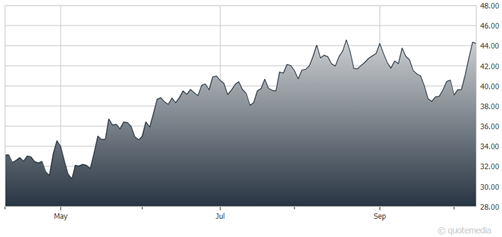NGLs is a catch-all term for a long list of hydrocarbons found naturally in the raw natural gas stream produced from wells in certain regions of the US. Specifically, natural gas is really methane – CH4 – a carbon atom bonded to 4 hydrogen atoms.
The two most common NGLs are ethane (C2H6) and propane (C3H8), which combined typically account for around three-quarters of a mixed barrel of NGLs by volume produced. Generally, raw natural gas is processed to separate NGLs from methane. Then, NGLs can be fractionated to separate a mixed barrel of NGLs into volumes of ethane, propane, butane, and other hydrocarbons.
EQT Corp. (NYSE:EQT)
Many of the oil- and gas-focused exploration and production companies in our coverage universe have some exposure to NGLs output and will benefit from a healthier supply/demand balance in coming years. In Energy & Income Advisor, we’ve generally preferred to focus on gas-focused producers with exposure to two major gas shale fields, the Marcellus Shale of Appalachia and the Haynesville Shale of Louisiana.
The former is the lowest cost gas-focused field in the US with breakeven costs for quality producers like EQT (ST:EQTAB) generally under $2.40/MMBtu. We also like the Haynesville Shale because while it’s a higher cost gas field than the Marcellus, it’s located close to the US Gulf Coast, home to most US LNG exports, reducing transport costs.
Producers also have the potential to ramp up production from the Haynesville more quickly to meet growing demand for exports, provided gas prices are at or above the $3.50/MMbtu to $4/MMBtu region that’s required for Haynesville producers to generate significant free cash flow.
While we still favor the Haynesville as a play on LNG growth and natural gas specifically, it’s almost entirely a dry gas field – gas produced in the region typically continues only tiny volumes of NGLs or oil. In contrast, the Marcellus Shale contains both wet gas and dry gas windows.
Recommended Action: Buy EQT.
